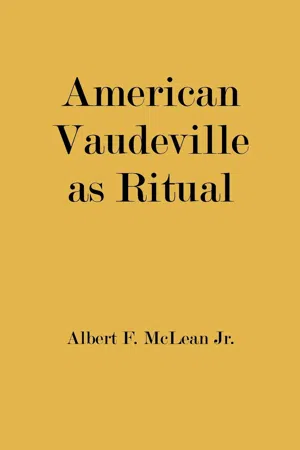![]()
Notes
ONE
1 Contemporary thought regarding myth has not yet reached a clear consensus, and the relation between myth and ritual is a matter of considerable debate. Although the present study has had to delve further into the theoretical implications of myth than other comparable works in American studies, such as Smith’s Virgin Land and Hofstadter’s Age of Reform, clarity still demands firm and workable definitions of terms. Myth, as it is used in these pages, is a constellation of images and symbols, either objectively real or imaginary, which brings focus and a degree of order to the psychic (largely unconscious) processes of a group or society and in so doing endows a magical potency upon the circumstances or persons involved. Ritual is a repetitious and public presentation of the materials proper to mythical thought, which shares with myth its concern with psychic life, but which, because of its dramatic medium, operates more fluidly and more instantaneously. The word rite, often used interchangeably with ritual, has been excluded from this discussion because of its more explicit connotations of religious worship. These definitions are, on the whole, a compendium and distillation of the definitions to be found in the following sources: Henry A. Murray (ed.), Myth and Myth Making (New York, 1960), pp. 318-49; Susanne K. Langer, Philosophy in a New Key (Cambridge, Mass., 1960), pp. 36-50, 152-60; and Ernst Cassirer, The Philosophy of Symbolic Forms, II (New Haven, 1955), pp. 38-41.
2 Cp. Mark Schorer, “The Necessity of Myth,” in Murray, Myth and Myth Making, p. 355: “Myths are the instruments by which we continually struggle to make our experience intelligible to ourselves. A myth is a large controlling image that gives philosophical meaning to the facts of ordinary life; that is which has organizing value for experience.”
3 The pioneer work in this field was Arthur M. Schlesinger, The Rise of the City, 1878-1898 (New York, 1933), but other significant contributions have been Henry Nash Smith, Virgin Land (Cambridge, Mass., 1950); Richard Hofstadter, The Age of Reform (New York, 1955); Henry F. May, Protestant Churches and Industrial America (New York, 1949); Eric F. Goldman, Rendezvous with Destiny (New York, 1952); and Samuel P. Hays, The Response to Industrialism: 1885-1915 (Chicago, 1957).
4 Cp. Susanne K. Langer, Philosophy in a New Key, p. 49: “Ritual is a symbolic transformation of experiences that no other medium can adequately express. Because it springs from a primary human need, it is a spontaneous activity—that is to say without intention, without adaptation to a conscious purpose; its growth is undesigned, its pattern purely natural, however intricate it may be.”
5 Cassirer has particularly stressed the manner in which myth and ritual operate below the level of conscious thought. Thus the myth-making process becomes one of immediacy and of what he calls an “interpenetration” of idea and object: “Rites cannot be explained as a mere representation of beliefs; on the contrary, the part of myth which belongs to the world of theoretical representation, which is a mere record or accredited narrative, must be understood as a mediate interpretation of the part which resides immediately in the activity of man and in his feelings and will. Seen in this light, rites are not originally ‘allegorical’; they do not merely copy or represent but are absolutely real; they are so woven into the reality of action as to form an indispensable part of it.” Philosophy of Symbolic Forms, II, p. 39. See also Stanley E. Hyman, “The Ritual View of Myth and the Mythic,” in Myth a Symposium, ed. Thomas A. Sebeok (Bloomington, 1958), pp. 84-94.
6 This point was originally suggested to me by Richard Chase, The Quest for Myth (Baton Rouge, 1949), pp. 7-30, 69. Other passages in this book bear directly on this problem of myth-making in modern civilization.
7 Charles and Mary Beard, The Rise of American Civilization, II (New York, 1937), p. 397.
8 Kenneth S. Lynn, The Dream of Success (Boston, 1955). The discussion of the Alger tales in the first chapter of this book is particularly good.
9 Cp. Howard Mumford Jones, The Pursuit of Happiness (Cambridge, Mass., 1953), especially his discussion of the modern “technique of happiness,” pp. 131 ff.
10 Jones quotes Dorothy Thompson’s article from the Ladies Home Journal, LVIII (April 1941), 6, to the effect that “In this democracy it has become a public duty to be as happy as one can be.”
11 R. G. Collingwood, The Principles of Art (New York, 1958), pp. 57-104. Johan Huizinga, Homo Ludens: The Study o...
